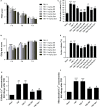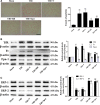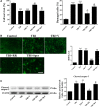Role of mitochondrial calcium uniporter-mediated Ca2+ and iron accumulation in traumatic brain injury
- PMID: 30756474
- PMCID: PMC6433723
- DOI: 10.1111/jcmm.14206
Role of mitochondrial calcium uniporter-mediated Ca2+ and iron accumulation in traumatic brain injury
Abstract
Previous studies have suggested that the cellular Ca2+ and iron homeostasis, which can be regulated by mitochondrial calcium uniporter (MCU), is associated with oxidative stress, apoptosis and many neurological diseases. However, little is known about the role of MCU-mediated Ca2+ and iron accumulation in traumatic brain injury (TBI). Under physiological conditions, MCU can be inhibited by ruthenium red (RR) and activated by spermine (Sper). In the present study, we used RR and Sper to reveal the role of MCU in mouse and neuron TBI models. Our results suggested that the Ca2+ and iron concentrations were obviously increased after TBI. In addition, TBI models showed a significant generation of reactive oxygen species (ROS), decrease in adenosine triphosphate (ATP), deformation of mitochondria, up-regulation of deoxyribonucleic acid (DNA) damage and increase in apoptosis. Blockage of MCU by RR prevented Ca2+ and iron accumulation, abated the level of oxidative stress, improved the energy supply, stabilized mitochondria, reduced DNA damage and decreased apoptosis both in vivo and in vitro. Interestingly, Sper did not increase cellular Ca2+ and iron concentrations, but suppressed the Ca2+ and iron accumulation to benefit the mice in vivo. However, Sper had no significant impact on TBI in vitro. Taken together, our data demonstrated for the first time that blockage of MCU-mediated Ca2+ and iron accumulation was essential for TBI. These findings indicated that MCU could be a novel therapeutic target for treating TBI.
Keywords: Ca2+; iron; mitochondrial calcium uniporter; neuroprotection; traumatic brain injury.
© 2019 The Authors. Journal of Cellular and Molecular Medicine published by John Wiley & Sons Ltd and Foundation for Cellular and Molecular Medicine.
Conflict of interest statement
The authors declare no potential conflicts of interest.
Figures








Similar articles
-
Blockage of mitochondrial calcium uniporter prevents iron accumulation in a model of experimental subarachnoid hemorrhage.Biochem Biophys Res Commun. 2015 Jan 24;456(4):835-40. doi: 10.1016/j.bbrc.2014.12.073. Epub 2014 Dec 19. Biochem Biophys Res Commun. 2015. PMID: 25529443
-
Role of Mitochondrial Calcium Uniporter in Early Brain Injury After Experimental Subarachnoid Hemorrhage.Mol Neurobiol. 2015 Dec;52(3):1637-1647. doi: 10.1007/s12035-014-8942-z. Epub 2014 Nov 5. Mol Neurobiol. 2015. PMID: 25370932
-
Importance of mitochondrial calcium uniporter in high glucose-induced endothelial cell dysfunction.Diab Vasc Dis Res. 2017 Nov;14(6):494-501. doi: 10.1177/1479164117723270. Epub 2017 Aug 4. Diab Vasc Dis Res. 2017. PMID: 28777009 Free PMC article.
-
Glutamate excitotoxicity and Ca2+-regulation of respiration: Role of the Ca2+ activated mitochondrial transporters (CaMCs).Biochim Biophys Acta. 2016 Aug;1857(8):1158-1166. doi: 10.1016/j.bbabio.2016.04.003. Epub 2016 Apr 7. Biochim Biophys Acta. 2016. PMID: 27060251 Review.
-
The Function of the Mitochondrial Calcium Uniporter in Neurodegenerative Disorders.Int J Mol Sci. 2017 Feb 10;18(2):248. doi: 10.3390/ijms18020248. Int J Mol Sci. 2017. PMID: 28208618 Free PMC article. Review.
Cited by
-
Silica Nanoparticles from Melon Seed Husk Abrogated Binary Metal(loid) Mediated Cerebellar Dysfunction by Attenuation of Oxido-inflammatory Response and Upregulation of Neurotrophic Factors in Male Albino Rats.Cerebellum. 2024 Dec;23(6):2426-2445. doi: 10.1007/s12311-024-01747-1. Epub 2024 Sep 27. Cerebellum. 2024. PMID: 39331240
-
Neurological Manifestations Following Traumatic Brain Injury: Role of Behavioral, Neuroinflammation, Excitotoxicity, Nrf-2 and Nitric Oxide.CNS Neurol Disord Drug Targets. 2025;24(1):47-59. doi: 10.2174/0118715273318552240708055413. CNS Neurol Disord Drug Targets. 2025. PMID: 39082170 Review.
-
Examining Sporadic Cancer Mutations Uncovers a Set of Genes Involved in Mitochondrial Maintenance.Genes (Basel). 2023 Apr 29;14(5):1009. doi: 10.3390/genes14051009. Genes (Basel). 2023. PMID: 37239369 Free PMC article.
-
The mRNA Decay Factor CAR-1/LSM14 Regulates Axon Regeneration via Mitochondrial Calcium Dynamics.Curr Biol. 2020 Mar 9;30(5):865-876.e7. doi: 10.1016/j.cub.2019.12.061. Epub 2020 Jan 23. Curr Biol. 2020. PMID: 31983639 Free PMC article.
-
Inflammatory Signaling Induces Mitochondrial Dysfunction and Neuronal Death in Traumatic Brain Injury via Downregulation of OXPHOS Genes.Biochem Genet. 2024 Dec 10. doi: 10.1007/s10528-024-10980-6. Online ahead of print. Biochem Genet. 2024. PMID: 39656403
References
-
- Brooks JC, Strauss DJ, Shavelle RM, Paculdo DR, Hammond FM, Harrison‐Felix CL. Long‐term disability and survival in traumatic brain injury: results from the National Institute on Disability and Rehabilitation Research Model Systems. Arch Phys Med Rehabil. 2013;94:2203‐2209. - PubMed
-
- Ding K, Wang H, Xu J, et al. Melatonin stimulates antioxidant enzymes and reduces oxidative stress in experimental traumatic brain injury: the Nrf2‐ARE signaling pathway as a potential mechanism. Free Radic Biol Med. 2014;73:1‐11. - PubMed
-
- Zhang L, Wang H. Targeting the NF‐E2‐related factor 2 pathway: a novel strategy for traumatic brain injury. Mol Neurobiol. 2017. - PubMed
-
- Sun M, Zhao Y, Gu Y, Zhang Y. Protective effects of taurine against closed head injury in rats. J Neurotrauma. 2015;32:66‐74. - PubMed
Publication types
MeSH terms
Substances
LinkOut - more resources
Full Text Sources
Medical
Miscellaneous

